Review for Dragon Ball Z Kai Season 1
Introduction
I thought I’d never have anything to do with another Dragon Ball property again, but it keeps sucking me back in. After Manga released Dragon Ball Z, they went for GT, and then the original Dragon Ball series as well, and they’ve also dabbled in a couple of the movies too (One came free with a Dragon Ball collection if you’re wondering). This time it’s curiosity that got the better of me. I had the dubious pleasure of watching all 291 episodes of Dragon Ball Z for this site, and there were points where I wished it could be shorter. I’d get to fondly wonder at what the show might be like if it was shorn of those ten minute recaps, the flashback sequences to previous episodes, the stretching of action sequences (a five minute countdown ran to over eight episodes in one storyline). And of course the filler, what would Dragon Ball Z be like if it was just like the original manga?
It would be 159 episodes long, just over half the length. I know that because for the show’s 25th anniversary, this Dragon Ball Kai show was created, re-editing the series to eliminate the filler, the flashbacks and to tighten the pace, as well as perform some restoration on the original footage, and Manga Entertainment are now bringing it out here on Blu-ray. In this case, Blu-ray is a good thing, as Dragon Ball Z was animated with cel and paint, and shot on 16mm film, and it’s ripe for an HD presentation. It’s also ideal for purists. Funimation, from whom all English territory Dragon Ball property is sourced, have released Dragon Ball Z on several occasions. The ultimate DVD releases were the Dragon Boxes, which are long since deleted. But for the mass market, they released the Orange sets, which took the original animation and cropped it for widescreen sets, and those are the DVDs we got in the UK. Some of the cropping is unkind, and it’s not the ideal way to watch the show.
When it came to the Blu-ray release, Funimation began by doing a frame by frame restoration on the original source material and mastering the Blu-rays in-house, keeping the original aspect ratio and look of the film. The Level Sets were expensive to produce, and they didn’t sell at all well. They were cancelled after two volumes. Funimation then tried again, by re-mastering the orange boxes to HD, that’s Dragon Ball Z cropped to widescreen but now DNR’d to the point that all grain is eliminated, and all the colours look as if the show had been created in CGI digipaint. It looks plastic. If you’ve bought any of the Funimation sourced Blu-rays that Manga have released in the past 2 years, you might have seen trailers for both versions of Dragon Ball Z and have your own opinion on which is preferable. But I’m someone who prefers original aspect ratio and original creator intent.
That’s where Dragon Ball Z Kai comes in. It was crafted from the original Dragon Ball Z footage, restored by the Japanese creators, and it’s in the original aspect ratio, and it looks like it’s shot on film, just the way it’s supposed to. It’s as close as we are ever going to get to Dragon Ball Z on Blu-ray looking the way it should. Of course because it’s a whole new edit, both versions get new dubs, in English and Japanese. It’s the prospect of seeing Dragon Ball Z in this kind of quality that has me venturing forth once more for a review, despite the fact that there were points in the original show that I actually preferred the filler. When Funimation released Dragon Ball Z Kai in the US, they did it the way they release all new, long running series, in 13-odd-episode, 2-disc instalments. Manga Entertainment are doubling up on discs, going straight for the season sets so we should eventually get it all in six releases. Note that Funimation are up to Season 4 so far. It’s also worth noting in this online streaming, niche anime culture age, that Dragon Ball Z Kai is one series that still gets a traditional TV broadcast in the UK, on the Kix satellite channel.
It's been five years since the events of Dragon Ball. Goku has settled down with Chichi, and together they have a son, Gohan, the apple of his parents' eyes. Gohan is a little timid, and spoiled by a mother who would much rather have a genius in the family than another martial artist saviour of the universe. Not that there is much saving to be done. The world is at peace, and even Piccolo's behaving himself.
Then suddenly, that peace is shattered when aliens arrive, or rather one alien, Raditz, a Saiyan, looking for his brother Kakarott. The Saiyans are the most brutal race in the universe; their trade is attacking planets, stripping them of the inhabitants, and selling them off at a profit. The one saving grace is that a stellar disaster wiped most of them out. There are only three left in the universe, four counting Kakarott, and Raditz is looking for his kid brother to recruit him to his nefarious cause. It turns out that Kakarott is actually Goku, and Goku forgot about his Saiyan heritage when he fell on his head as child. When Raditz learns that Goku has a son, whose Saiyan powers may be enhanced by his Earthling blood, the need to coerce both his relatives to his cause becomes intense, and a battle to the death ensues. But that's only the beginning, for there are two more Saiyans out there, and they now know of ripe little Earth's existence. They're coming to wipe out the inhabitants of Earth, and there's only a year to train up to be ready for them. Even little Gohan will have to undergo training. Training will be hard for Gohan, who's never wanted for anything in his four pampered years. It'll be even harder for Goku, who's dead. Time to start gathering the Dragon Balls again.
The first 26 episodes of Dragon Ball Z Kai are presented across 4 Blu-ray discs from Manga Entertainment. This first instalment will also be available on DVD.
Disc 1
1. Prologue to Battle! The Return of Goku!
2. The Enemy is Goku’s Brother?! The Secret of the Mighty Saiyan Warriors!
3. A Life or Death Battle! Goku and Piccolo’s Desperate Attack!
4. Run in the Afterlife, Goku! The One Million Mile Snake Way!
5. Wilderness Survival! A Moonlit Night Awakens Gohan!
6. The End of Snake Way! King Kai’s Bizarre Test!
7. The Battle with Ten-Times Gravity! Goku’s Race Against the Clock!
8. Shenron Appears! The Saiyans Arrive Sooner Than Expected!
9. Yamcha’s Struggle! The Terrible Saibamen!
Disc 2
10. Sit Tight Chiaotzu! Tien’s Screaming Tri-Beam!
11. Will Goku Make it in Time?! Three Hours Until the Battle Resumes!
12. Farewell Piccolo! Goku’s Furious Counterattack!
13. The Power of the Kaio-Ken! Goku vs. Vegeta!
Disc 3
14. An All-Out Kamehameha! Vegeta’s Terrible Transformation!
15. Goku on the Ropes! Pin Your Hopes on the Spirit Bomb!
16. Defeat the Invincible Vegeta! Work a Miracle, Gohan!
17. Dawn of a Fierce Battle! The Star of Hope is Piccolo’s Homeland!
18. The Ship Resting in Yunzabit! Time to Blast Off for Planet Namek!
19. A Powerful New Foe! Frieza, Ruler of the Universe!
20. The Rebellion Against Frieza! Vegeta’s Burning Ambition
21. Protect the Dragon Balls! The Namekian’s All-Out Attack!
22. Dodoria’s Terrifying Chase! A Truth Revealed to Vegeta1
Disc 4
23. Vegeta’s Covert Maneuvers! A Tragic Assault on the Namekians!
24. Friends Reborn! Zarbon’s Hideous Transformation!
25. Power Up Krillin! Frieza’s Mounting Apprehension!
26. The Scheme is Shattered! Vegeta Strikes Back at Zarbon!
Picture
Dragon Ball Z Kai gets a 4:3 pillarboxed transfer on these Blu-ray discs, reflecting the original aspect ratio of the show. So no more cropped heads and awkward framing as per the original DVD release of Dragon Ball Z. And given the more reverent restoration given to the show in Japan, there’s no excessive DNR erasing detail, the film grain is still there, and colours are faithful to the vintage of the show. It’s a decent transfer of a show which was originally animated on 16mm film. The show lacks the pin-sharp image that you might expect from a 35mm source, but generally the image is stable, sharp, and with consistent colours, bringing across the budget animation to satisfying effect.
That’s with the odd exception. The opening and closing themes, as well as the eye-catches to the show have been animated anew for this Kai release, and it’s here that you’ll find the sharpness and clarity suddenly taking a leap upwards into the full 1080p HD age. It looks like a different show at this point, and gives some idea of what the new Dragon Ball Super TV series will look like when it is broadcast in the near future. There are also odd moments in the animation where it becomes clear that the animators just couldn’t salvage the original frame for restoration, or perhaps a new scene had to be animated to maintain the continuity of the new edit. It’s here that you might find the clarity suddenly and briefly taking a boost upwards for a few frames, although the colours, film grain, and animation remain consistent with the rest of the show.
The images in this review are sourced from the PR, and aren’t necessarily representative of the final retail release.
Sound
You have the choice between Dolby TrueHD 5.1 Surround English and 2.0 Stereo Japanese with optional translated subtitles and a signs only track. As mentioned, the show gets a whole new dub in both languages, and what little I sampled of the English audio was robust enough. I watched the show through in Japanese though, and other than the odd fourth wall breaking moment where I heard Aya Hirano’s voice for Dende, it was similar enough to Dragon Ball Z to feel very comfortable to watch. One issue might be that this was one of the early Funimation Blu-rays and has a thin white font to its subtitles that can be lost against busy backgrounds.
There was a bit of controversy with Dragon Ball Z Kai. For its broadcast in Japan, it received a new musical score from Kenji Yamamoto, who had created music for several of the Dragon Ball video games, here replacing the original Dragon Ball Z score from Shunsuke Kikuchi. About a hundred episodes into the broadcast, it was noted that there was a degree of similarity between Yamamoto’s music and other scores, and he was removed from the project. Toei also went back and replaced most of the music (aside from the new theme songs and the ad bumper music) with the original Kikuchi score for the Japanese home video release and subsequent rebroadcasts, and also instructed foreign licensees to do likewise. By this point, Funimation had released the first four, half season sets on Blu-ray with the Yamamoto score. They continued to release subsequent collections with the Kikuchi score, but only fixed the first lot of episodes when they re-released them as full season sets. Manga Entertainment are going straight for the full season sets, and they are using the Funimation masters. These should all be original music, but it looks as if they have the wrong masters for the first two discs, as the music is the radically different Yamamoto score for the first thirteen episodes.
Extras
These discs look like the Funimation discs, repurposed for the UK release (replacing the Funimation logo with a Manga UK logo, and changing the trailers.) Hence in the first Season collection, you find discs labelled Part 1, Discs 1 and 2, and Part 2, Discs 1 and 2.
The discs present their content with animated menus, but the episode select screens are a waste of time, with the episode titles written in a small yellow font against a white background, too small to read at a reasonable viewing distance from your TV.
Disc 2 offers textless credits and a trailer reel with Soul Eater Part 3 DVD, Evangelion 1.11, and Dragon Ball Z Kai: Part 2, all presented in HD. Funimation will usually have more trailers (including one for Funimation.com) and let you play them individually.
Part 2, discs 3 and 4 of this collection, more sensibly present their episodes and options with black text against white backgrounds, but the font is still too small. The extras on disc 4 offer three textless opening credits, one textless closing, and trailers for Evangelion 1.11, and Sengoku Basara Season 1.
Conclusion
Well, I better set my stall out early on this one. I don’t like Dragon Ball Z. I’m not a fan of the long-running shonen action genre, the one with all the tournament fighting, the levelling up of abilities, the succeeding through superior willpower alone, and for me Dragon Ball Z is the nadir of the genre, the first and the worst so to speak. I also learned, given the number of times I fell asleep during the review discs, that three years is far too soon for me to be revisiting this particular universe. I did like the original Dragon Ball, briefly, for the opening ten episodes or so, which adapted the story before Akira Toriyama decided to change from a gag manga to a fighting manga. But what came afterwards was definitely not my cup of tea. Then again, if I knew what appealed to the mainstream anime and manga audience, I’d be the independently wealthy creator instead of the reviewer.
The irony is that by taking Dragon Ball Z, and reducing it to the essential manga storyline, it takes out that which made it bearable for me, the filler episodes that offered the kind of gag comedy and low-rent humour that typified the start of Dragon Ball. There’s very little of that left (aside from one moment where Muten Roshi’s hand strays too close to a nurse’s derriere). What we have here is pure Dragon Ball Z action. But Kai also removes the endless flashbacks, the previews, the standing around talking about how amazing the last fight move was, the explanations of how devastating the next fight move will be, all the little tricks that the Dragon Ball Z animators used to stretch 10 minutes into four episodes. What we get here are tightly edited and well paced episodes, around the first sixty episodes of Dragon Ball Z condensed into 26 episodes of Dragon Ball Z Kai.
It turns out that there was a lot more filler at the start of Dragon Ball Z than at the end, as while the overall compression is about 50%, the first 39 episodes of the show squeeze into just the first sixteen here. We don’t get ten episodes of Goku running along the back of a snake anymore; it’s over in just two. But more importantly the episodes are structured so much better in terms of satisfying narrative. Originally you might get fights stretched over two or three episodes, episodes practically flowing from one to the next without any real climax or resolution. Dragon Ball Z Kai really does fix this. It keeps the fights short and sweet for one thing, really able to concentrate on the action first and foremost, and cutting out on the dead-weight. But the episodes all feel like they have a story to them, a beginning, middle and end, and even when they cliff-hanger over, there’s a feeling of climax at the cliff-hanger, a dramatic crescendo that at least satisfies and rewards you for spending the last twenty minutes with the show.
Personally I want story, not fighting, and I want characters, not single notes of intent. I’m never going to like Dragon Ball Z Kai, but I found it a lot more bearable than Dragon Ball Z, and given that I’m basically watching the same story again without the first time glow of discovery that I get with any new show, that’s an indication of how much Kai improves on the original in terms of pacing and efficiency. It’s ruthlessly edited down to the essential manga storyline, and it flows so much better than Dragon Ball Z that you forgive the odd continuity error that might result.
Best of all, you get to see the show as it was meant to be seen, in the original aspect ratio, with the film source given a sympathetic restoration, that retains the original look and grain structure of the image, instead of plasticising and cropping it like Funimation have done to their Dragon Ball Z Blu-rays. If you are a Dragon Ball Z fan, then you will be very pleased with these Dragon Ball Z Kai discs.
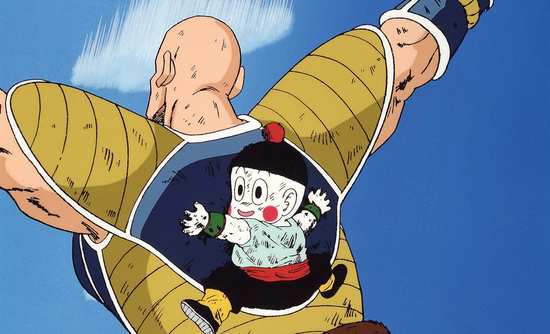
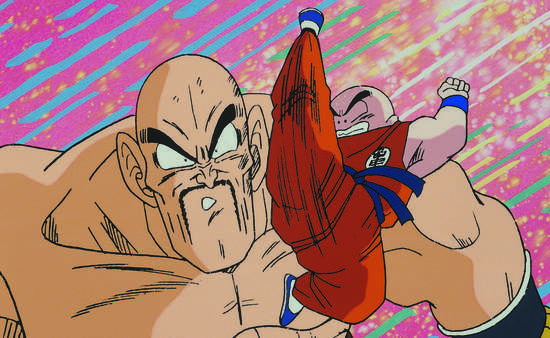
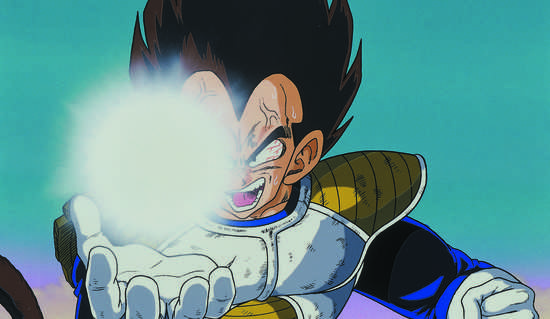
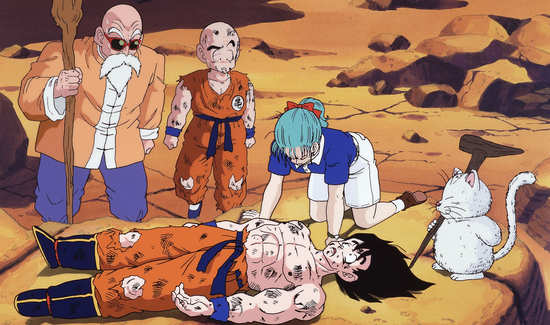
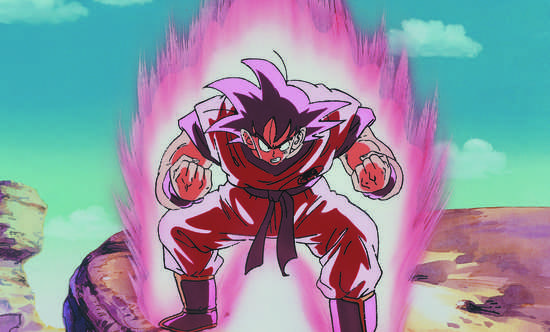
Your Opinions and Comments
Be the first to post a comment!